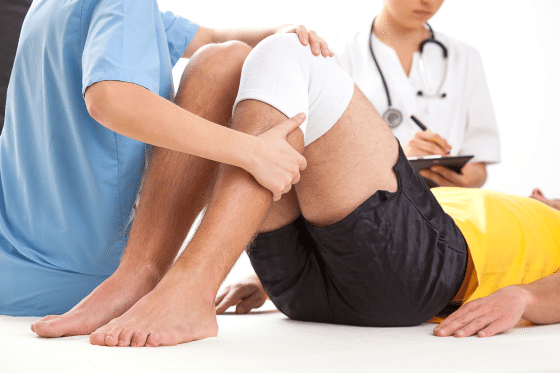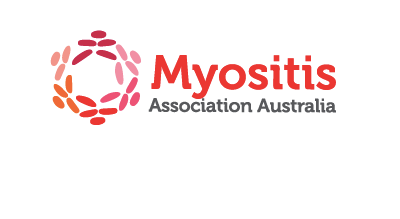What is Polymyositis?
Polymyositis is a connective tissue disease that triggers inflammation and muscular weakness.
The cause is unknown, but Polymyositis is thought to be an autoimmune disorder, possibly triggered by a viral infection of muscle tissue.
The disease is more common in women than men and tends to develop between the ages of 50 to 70 years, although anyone of any age or sex can be affected.
Since symptoms differ between individuals, Polymyositis is hard to diagnose. In many cases, Polymyositis is associated with other autoimmune disorders of connective tissue such as scleroderma, systemic lupus erythematosus, rheumatoid arthritis, Raynaud’s syndrome, and Sjogren’s syndrome.
In recent years, advancements in antibody testing and the medical understanding of the different Myositis subtypes have led many health professionals to believe that Polymyositis may be rarer than previously thought.
As such, some patients previously diagnosed with Polymyositis may be better described as having an alternate diagnosis such as:

Signs and Symptoms
- Symmetrical muscular weakness of shoulders and hips
- Muscle wastage
- Muscle pain
- Fatigue
- Breathlessness
- Swallowing difficulties
- Tremors, particularly of the hands;
- Wide-footed stance and walking style
- Clumsiness
- Tendency to fall over.
Progression of weakness
Polymyositis develops gradually over weeks or months. By the time the person experiences symptoms, they may have significant loss of muscle fibres. Difficulties may include:
- Profound muscular weakness in affected body parts, such as being unable to lift the arms above shoulder height or lift the head off a pillow
- Voice changes, if the muscles of the larynx are affected
- Problems with swallowing if the oesophagus is affected, with a tendency to regurgitate food
- Peristalsis (the muscular contractions of the bowel) may falter, leading to constipation
- In its later stages, the disease may cause the abnormal shortening of muscles (contracture)
- The head, hands and feet are usually untouched by the disease.
Possible complications
People living with Polymyositis may experience difficulties with breathing or swallowing if the associated muscles weaken too severely. Some of the other possible complications of Polymyositis include:
- Heart inflammation
- Heart attack
- Breast cancer
- Lung cancer
- Lung disease
- Pneumonia
- Respiratory failure
Some people with Polymyositis and Dermatomyositis may also have a further complication, Antisynthetase Syndrome. People with this syndrome have antisynthetase autoantibodies that attack a particular protein essential for our muscles to function well.
Currently, there are eight different types of antisynthetase antibodies relevant to Myositis that have been discovered. The most common being anti-Jo-1, followed by anti-PL-7 and anti-PL-12. Blood tests can be used to identify the presence of antisynthetase antibodies.
Some of the signs, symptoms and complications of Antisynthetase Syndrome include:
- Muscle inflammation, pain and stiffness
- Interstitial lung disease (ILD)
- Nonerosive arthritis
- Mechanic’s hands – a roughening and cracking of the skin of the tips and sides of the fingers
- Hiker’s feet – a roughening and cracking of the skin of the toes and soles of the feet
- Fever
- Fatigue
- Loss of appetite or unintended weight loss
- Raynaud’s phenomenon – temporary disruption of blood flow to the small blood vessels in extremities. In response to cold or stress, your fingers, toes, the tip of the nose, lips and ears can turn blue, feel cold and numb. After the blood flow returns, you may feel tingling and throbbing in the affected areas.
What causes Polymyositis?
The cause of polymyositis has not been found, but there is good evidence to indicate that it is likely to be an autoimmune disorder. This means the immune cells mistakenly attack the muscle fibres of the body. When a small biopsy of affected muscle is examined in a laboratory, it looks withered and studded with immune system cells.
The immune system could damage muscle tissue by trying to rid the tissue of a viral infection.
People with Polymyositis are likely to have other connective tissue disorders, such as rheumatoid arthritis or scleroderma, so there could be genetic susceptibility. People with Polymyositis also tend to have family members with connective tissue disorders, further supporting the inherited tendency theory.
How is Polymyositis diagnosed?
Polymyositis is sometimes mistaken for muscular dystrophy, so careful diagnosis is important. Some of the tests for Polymyositis include:
- Medical history: People with other connective tissue diseases, such as scleroderma, are at greater risk of Polymyositis
- Physical examination: including general tests
- Electromyography: wires attached to the skin measure the electrical activity of muscles
- Muscle biopsy: a small tag of muscle tissue is removed and examined in a laboratory for evidence of degeneration and abnormal immune system activity. This is the gold standard test for Polymyositis
- Scans: including magnetic resonance imaging
- Blood tests: including an antibody titre because Polymyositis is characterised by the overproduction of particular antibodies. There can also be higher than normal amounts of a muscle enzyme indicating muscle damage (CK – creatine phosphokinase) circulating in the bloodstream, which can be measured by a specific blood test
- Other tests: to exclude other causes such as bacterial or parasitical infections of muscle tissue.
How is Polymyositis treated?
The outlook for Polymyositis is hard to predict. Some people will recover, most will respond satisfactorily to treatment, while others may experience life-threatening complications. Treatment options include:
- Corticosteroids: to dampen the activity of the immune system and reduce inflammation. For some people, corticosteroids contribute to muscle weakness, so other medications have to be used instead
- Immunosuppressive drugs: such as azathioprine and methotrexate
- Plasmapheresis: the antibodies responsible for attacking muscle tissue are removed from the bloodstream by plasmapheresis. Blood is taken from the patient and the blood cells separated from the plasma. Only the blood cells are returned to the patient, leaving the antibodies behind in the plasma;
- Immunoglobulin: a special protein obtained from the plasma of blood donors, and administered intravenously, has sometimes had good results in difficult cases
- Physical therapy: to help strengthen muscles
- Ongoing monitoring: including blood tests, so that the medications can be adjusted if necessary. Generally, the initial doses are high then gradually tapered down.
Muscular Dystrophy Australia has given permission to the Myositis Association-Australia Incorporated to reproduce information from their Polymyositis fact sheet to include on this page.

Stay up to date
Research is moving forward at a fast pace, so this research summary may not be up-to-date at the time of reading. One of the best ways to stay up to date with the latest on research is to become a member. We regularly provide updates on research in our bi-monthly member newsletters.
